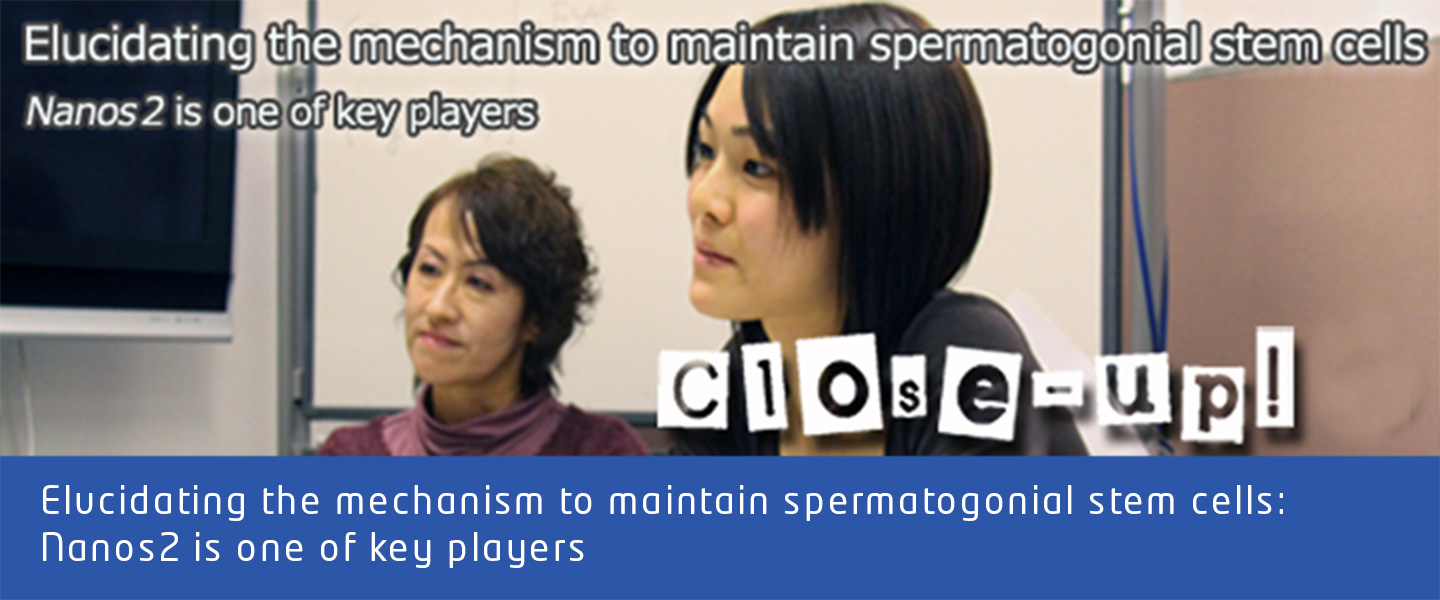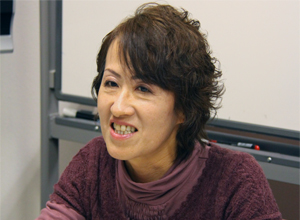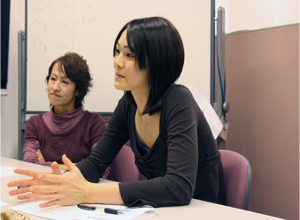Nanos2: key player for maintenance of spermatogonial stem cells

Yumiko SAGA, D. Sc., Professor,
Mammalian Development Laboratory,
Genetic Strains Research Center,National Institute of Genetics/ SOKENDAI.
Aiko SADA, Ph.D Student,
Department of Genetics, SOKENDAI.
(Graduate University for Advanced Studies)
Stem cells produce differentiated cells throughout our life. In the human body, stem cells reside in various parts such as the bone marrow, skin and testes. Recently, Researcher Ms. Aiko SADA, under the instruction of Prof. Yumiko SAGA in the Mammalian Development Laboratory, has identified a gene that is specifically expressed in spermatogonial stem cells and revealed a part of the mechanism for the maintenance of stem cells.
Generally, the term “cells” refers to differentiated cells, which, after a certain number of divisions, reach the end of their life and die. Stem cells, on the other hand, continue to renew themselves and produce their daughters that proceed to differentiation. For example, hematopoietic stem cells in the bone marrow are pluripotential and differentiate into various types of blood cells: red blood cells, white blood cells (neutrophiles, leukocytes and lymphocytes) and thrombocytes. Stem cells are “supply centers” of differentiated cells located in various parts of the body.
Much is still unknown about the behavior of stem cells, although they play an extremely important role in the maintenance of life. For example, it is extremely difficult to pinpoint the location of stem cells in organs or tissues. Dr. Saga says, “In the case of spermatogonial stem cells, it is possible to verify the existence of stem cells in a candidate cell group if sperms are produced normally after the transplantation of the cell group in an empty testis, but this method doesn’t enable us to go as far as identifying stem cells in vivo.” She has been searching for genes that perform an important function in the development of germ cells as part of her embryological research since about ten years ago.

Nanos2 is one such candidate gene. The recent research achievement has resulted from analysis of Nanos. “I decided to find out what role this gene plays in the differentiation of germ cells in mammals,” explains Dr. Saga. Cloning using mice led to discover the existence of three homologs ofNanos( Nanos1, 2 and 3). Mice in which Nanos1 was knocked out showed no influence on germ cell development. Whereas Nanos2 was expressed in male germ cells, and mice in which Nanos2 was knocked out could not produce sperms since their germ cells were lost during the embryonic period. “From these results, we learned that Nanos2 is important for the maintenance of male germ cells during embryogenesis, but it wasn’t possible to reveal the functions of Nanos 2 after birth, which expression was also observed in very limited germ cells during spermatogenesis,” says Dr. Saga.
It was in such a situation that Ms. Sada, who came to the NIG as a SOKENDAI postgraduate student, was chosen to further the research. She says: “I started with three central questions: what kind of cell expresses Nanos in the testis after birth?; what happens to mice if Nanos2 is knocked out at a certain point after birth?; whereas what happens if Nanos2 is artificially expressed in postnatal germ cells?”

It is known that spermatogonial stem cells reside in the undifferentiated cell group of spermatogonia. After several divisions, spermatogonia start meiosis, differentiating into spermatocytes, spermatids and then mature spermatozoa. However, spermatogonia are not uniform in their cell morphology or gene expression, and therefore it was not clear which spermatogonia were the “true stem cells.” Ms. Sada says, “From its expression pattern, it seems that Nanos2 was expressed in the most primitive set of spermatogonia.” So, using transgenic mice, she traced the fate of Nanos2-expressiong cells. It turned out, just as expected, that stem cells were there.
As the next step of the experiment, Nanos2 was knocked out in mice after birth. Within a few days, the stem cells disappeared, and sperm production was completely inhibited. In two months’ time, no sperm was found at all. On the other hand, Nanos2, which should normally disappear once differentiation starts, was manipulated so as to obtain its constant expression. As a result, spermatogonial stem cells were remained without differentiating into sperms. Later, the testes were full of stem-like cells.
Dr. Saga and Ms. Sada concluded that Nanos2 is expressed in spermatogonial stem cells and is indispensable for their maintenance as stem cells. Their research results were published in Science. Ms. Sada says, “I think our analysis based on experiments using live mice, which is quite time-consuming, was highly evaluated. I take a strong interest in the strict and yet flexible mechanisms found in mammals. The NIG is very well equipped for embryological research using mice, and this environment really facilitates my research.” They have already begun research into the genes downstream of Nanos2.
Dr. Saga says, “I am interested in everything related to embryogenesis. I hope that many students will come to the NIG to do meaningful research.” To Ms. Sada in particular, she sends warm words of praise and encouragement, “She has been working hard but in a relaxed manner in the NIG’s well-provided environment, repeating discussions with researchers from various fields. She has overcome her initial difficulty with English and looks ahead to an overseas post after graduation. I really hope that she’ll make her dream come true.” Let’s look forward to Ms. Sada’s international career.
(Interviewed by Naoko Nishimura on Dec. 16, 2009)
The RNA-Binding Protein NANOS2 is Required to Maintain Murine Spermatogonial Stem Cells
Aiko Sada, Atsushi Suzuki, Hitomi Suzuki, Yumiko Saga Science, Vol. 325. no. 5946, pp. 1394 – 1398, 2009. DOI: 10.1126/science.1172645
Back














